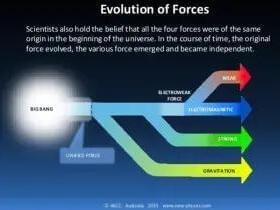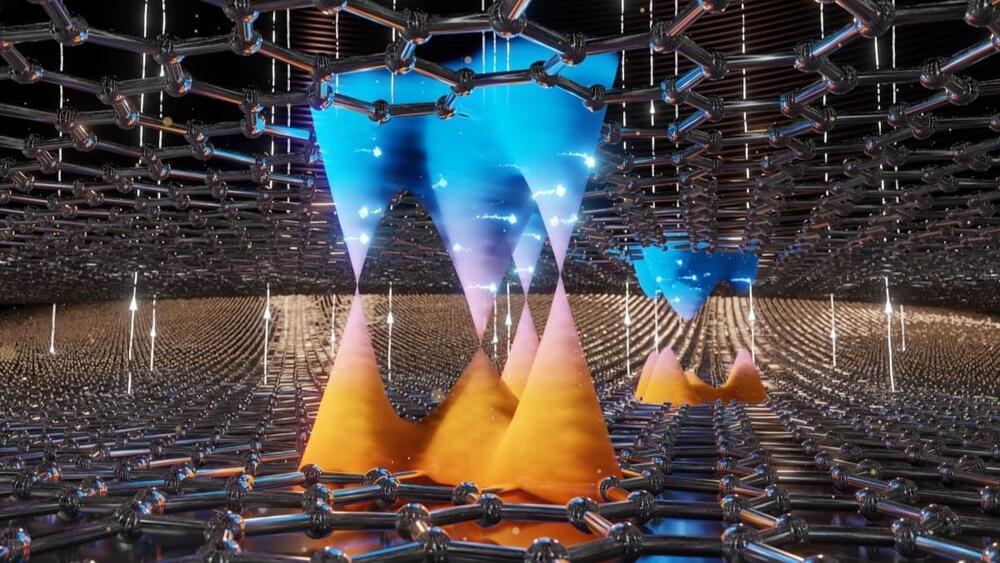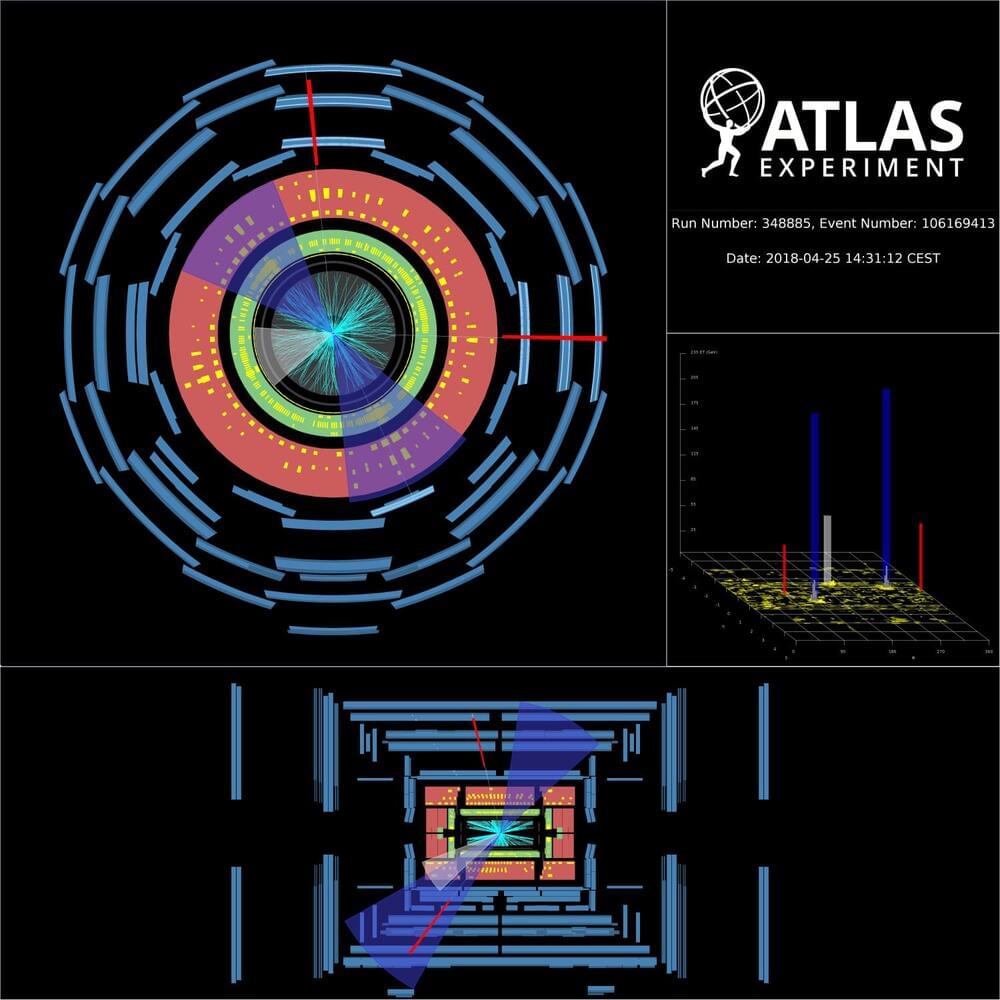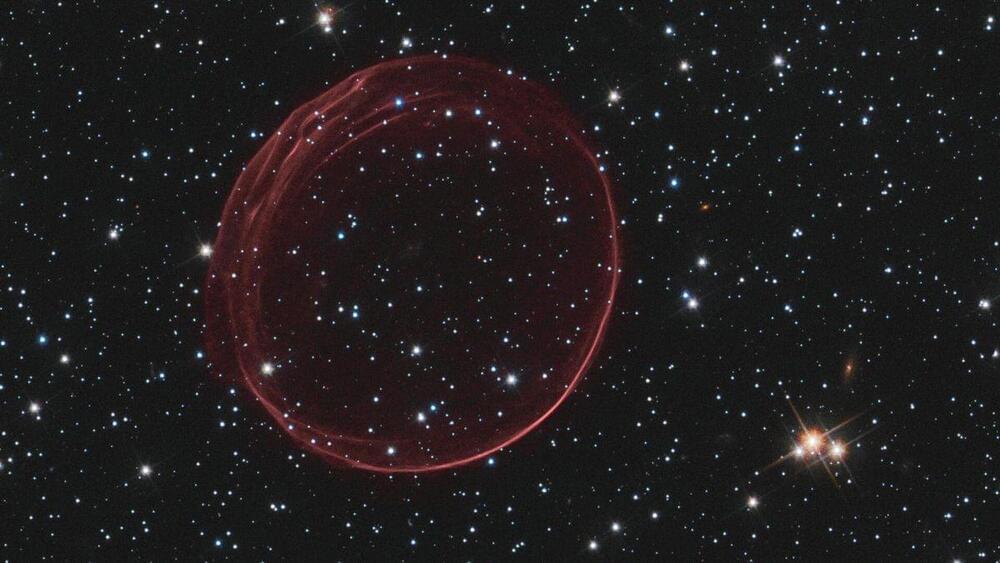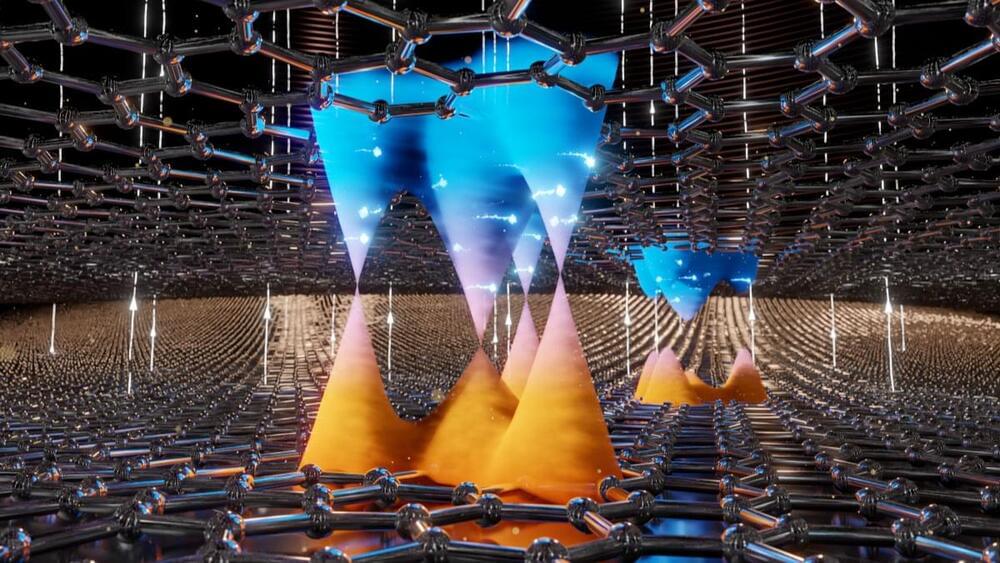Archive for the ‘particle physics’ category
Apr 19, 2024
School on Quantum Chaos
Posted by Dan Breeden in categories: education, evolution, particle physics, quantum physics, space
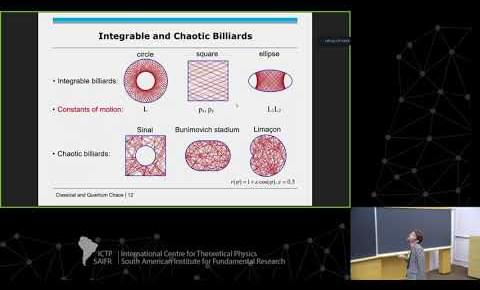
Quantum chaos focuses on the quantum manifestations of classical chaos. A characteristic of classical chaos is the exponential sensitivity of the dynamics with respect to infinitesimal changes in the initial conditions. Thus, to classify classical dynamics it is sufficient to follow phase space trajectories starting infinitesimally close to each other and to determine the evolution of their distances with respect to each other with time. Because of the uncertainty relation, this is no longer possible in the corresponding quantum system. One important aspect of quantum chaos is the understanding of features of the classical dynamics in terms of the fluctuation properties in the energy spectra of closed quantum systems or of the fluctuations exhibited by the scattering matrix elements describing open ones. The fluctuation properties are predicted to be universal, that is, to be the same for systems belonging to the same universality class and exhibiting the same chaotic behavior in the corresponding classical dynamics and to be describable by random matrix theory. Furthermore, random-matrix models that had been developed for the scattering matrix associated with compound-nuclear reactions have been shown to be applicable to quantum-chaotic scattering processes. A second important aspect within the field of quantum chaos concerns the semiclassical approach. In this context, one of the most important achievements was the periodic orbit theory pioneered by Gutzwiller, which led to understanding the impact of the classical dynamics on the properties of the quantum system in terms of purely classical quantities. The focus of research within the field of quantum chaos has been extended to relativistic quantum systems and to many-body quantum systems with focus on random matrix theory and the semiclassical approach. In distinction to single-particle systems, many-body systems like atomic nuclei do not have a classical analogue. In recent years different measures of chaos and models have been developed. Here, a prominent model is the Sachdev-Ye-Kitaev model which serves as a paradigm for the study of quantum chaos in strongly interacting many-body systems. The school is aimed at PhD students, post-docs and outstanding master students and the first part will provide a survey of single-and many-body quantum chaos and applications based on random-matrix theory and the semiclassical approach. The second part of the school will focus on current aspects of research in the context of many-body quantum chaos. There is no registration fee and limited funds are available for travel and local expenses. Organizers: Hilda Cerdeira (IFT-UNESP, Brazil) Barbara Dietz-Pilatus (Institute for Basic Science (IBS), Republic of Korea)
Apr 19, 2024
The idea that matter is mostly empty space is mostly wrong
Posted by Shubham Ghosh Roy in category: particle physics
Practically all of the matter we see and interact with is made of atoms, which are mostly empty space. Then why is reality so… solid?
Apr 19, 2024
Graphene’s Light-Speed Electrons Promise Revolution in Nanoscale Transistors
Posted by Saúl Morales Rodriguéz in categories: computing, nanotechnology, particle physics
Researchers have shown that double-layer graphene can function both as a superconductor and an insulator, a property that could revolutionize transistor technology. This dual functionality allows for the development of nanoscale transistors that are highly energy-efficient.
An international research team led by the University of Göttingen has demonstrated experimentally that electrons in naturally occurring double-layer graphene move like particles without any mass, in the same way that light travels. Furthermore, they have shown that the current can be “switched” on and off, which has potential for developing tiny, energy-efficient transistors – like the light switch in your house but at a nanoscale. The Massachusetts Institute of Technology (MIT), USA, and the National Institute for Materials Science (NIMS), Japan, were also involved in the research. The results were published in the scientific journal Nature Communications.
Apr 19, 2024
Researchers Develop “Goldene” — A New Form of Ultra-Thin Gold With Semiconductor Properties
Posted by Saúl Morales Rodriguéz in categories: chemistry, particle physics
For the first time, scientists have managed to create sheets of gold only a single atom layer thick. The material has been termed goldene. According to researchers from Linköping University, Sweden, this has given the gold new properties that can make it suitable for use in applications such as carbon dioxide conversion, hydrogen production, and production of value-added chemicals. Their findings are published in the journal Nature Synthesis.
Scientists have long tried to make single-atom-thick sheets of gold but failed because the metal’s tendency to lump together. But researchers from Linköping University have now succeeded thanks to a hundred-year-old method used by Japanese smiths.
“If you make a material extremely thin, something extraordinary happens – as with graphene. The same thing happens with gold. As you know, gold is usually a metal, but if single-atom-layer thick, the gold can become a semiconductor instead,” says Shun Kashiwaya, researcher at the Materials Design Division at Linköping University.
Apr 18, 2024
Symmetry’s guide to AI in particle physics and astrophysics
Posted by Dan Kummer in categories: internet, particle physics, robotics/AI
On November 30, 2022, Silicon Valley-based company OpenAI launched its artificial-intelligence-powered chatbot, ChatGPT. Overnight, AI transformed in the popular imagination from a science fiction trope to something anyone with an internet connection could try. ChatGPT was free to use, and it responded to typed prompts naturally enough to seem almost human. After the launch of the chatbot, worldwide Google searches for the term “AI” began a steep climb that still does not seem to have reached its peak.
Physicists were some of the earliest developers and adopters of technologies now welcomed under the wide umbrella term “AI.” Particle physicists and astrophysicists, with their enormous collections of data and the need to efficiently analyze it, are just the sort of people who benefit from the automation AI provides.
So we at Symmetry, an online magazine about particle physics and astrophysics, decided to explore the topic and publish a series on artificial intelligence. We looked at the many forms AI has taken; the ways the technology has helped shape the science (and vice versa); and the ways scientists use AI to advance experimental and theoretical physics, to improve the operation of particle accelerators and telescopes, and to train the next generation of physics students. You can expect to see the result of that exploration here in the coming weeks.
Apr 18, 2024
ATLAS explores Z boson production with heavy-flavour quarks
Posted by Shailesh Prasad in categories: computing, information science, particle physics
More than 40 years since its discovery, the Z boson remains a cornerstone of particle physics research. Through its production alongside heavy-flavour quarks (bottom and charm quarks), the Z boson provides a unique window into the internal dynamics of a proton’s constituents. Specifically, it allows researchers to probe the heavy-flavour contributions to “Parton Distribution Functions” (PDFs), which describe how a proton’s momentum is distributed among its constituent quarks and gluons. Using the full LHC Run-2 dataset, the ATLAS Collaboration measured Z boson production in association with both bottom (b) and charm © quarks, the latter for the first time in ATLAS. In their new result, physicists studied Z boson decays into electron or muon pairs produced in association with “jets” of particles. They focused on jets arising from the hadronisation of b or c quarks, creating two jet “flavours”: b-jets and c-jets. Physicists developed a new multivariate algorithm that was able to identify the jet-flavour, allowing them to measure the production of both Z+b-jets and Z+c-jets processes. Researchers then took this one step further and applied a specialised fit procedure, called the ‘flavour-fit’, to determine the large background contribution due to Z production together with other flavour jets. This method is driven by data and allows a precise description of the jet flavours for every studied observable. This led to a significant improvement in the precision of the results, allowing a more stringent comparison with theoretical predictions. The Z boson provides a unique window into the internal dynamics of a proton’s constituents. So, what did they find? ATLAS researchers measured the production rates (or “cross sections”) of several physics observables. These results were then compared with theoretical predictions, probing various approaches to describe the quark distributions in protons, the most recent computational improvements in QCD calculations and the effect of different treatments of the quark masses in the predictions. For example, Figure 1a shows the differential cross section for Z+1 b-jet production as a function of the transverse momentum of the most energetic b-jet in the event. Results show that predictions treating the b-quarks as massless (blue squares and red triangles) provide the best agreement with measurements. Z+2 b-jets angular observables are in general well understood, while some discrepancies with data appear in the invariant mass of the 2 b-jets, whose spectrum is not well modelled by the studied predictions. Figure 1: Measured fiducial cross-section as a function of a) leading b-jet pT for Z+b-jets events and b) leading c-jet x_F (its momentum along the beam axis relative to the initial proton momentum) for Z+c-jets events. Data (black) are compared with several theoretical predictions testing different theoretical flavour schemes, high order accuracy calculations and intrinsic charm models. (Image: ATLAS Collaboration/CERN) Studying Z+c-jets production offered a unique possibility to investigate the hypothesis of intrinsic (valence-like) components of c-quarks in the proton. With this result, the ATLAS Collaboration contributes to the long-standing debate on the existence of this phenomenon, currently supported by experimental measurements from the LHCb Collaboration. As shown in Figure 1b, the Z+c-jets results were compared with several hypotheses for intrinsic charm content. Due to the larger experimental and theoretical uncertainty on Z+c-jets processes, the current result makes no strong statement on the intrinsic c-quark component in the proton. However, it does improve physicists’ sensitivity to this effect, as the new data will be used in future by PDF fitting groups to set tighter constraints on the intrinsic charm distribution in the proton. Overall, the new ATLAS result provides deep insights for refining theoretical predictions, thereby fostering a deeper understanding of the dynamics of heavy-flavour quark content in the proton. About the event display: Display of a candidate Z boson decaying to two muons alongside two b-jets, recorded by the ATLAS detector at a centre-of-mass collision energy of 13 TeV. Blue cones indicate the b-jets, and the red lines indicate the muon tracks. Starting from the centre of the ATLAS detector, the reconstructed tracks of the charged particles in the inner detector are shown as cyan lines. The energy deposits in the electromagnetic (the green layer) and hadronic (the red layer) calorimeters are shown as yellow boxes. The hits in the muon spectrometer (the outer blue layer) are shown as light blue blocks. (Image: ATLAS Collaboration/CERN) Learn more Measurements of the production cross-section for a Z boson in association with b-or c-jets in proton-proton collisions at 13 TeV with the ATLAS detector (arXiv:2403.15093, see figures) Measurements of the production cross-section for a boson in association with in proton–proton collisions at 13 TeV (JHEP 7 (2020) 44, arXiv:2003.11960) LHCb Collaboration, Study of Z Bosons Produced in Association with Charm in the Forward Region (Phys. Rev. Lett. 128 (2022) 82,001, arXiv:2109.08084) See also the full list of ATLAS physics results.
Apr 18, 2024
The universe may be dominated by particles that break causality and move faster than light, new paper suggests
Posted by Shailesh Prasad in category: particle physics
With the nature of the universe’s two most elusive components up for debate, physicists have proposed a radical idea: Invisible particles called tachyons, which break causality and move faster than light, may dominate the cosmos.
Apr 18, 2024
Strange New Form of Gold Exists as a Sheet That’s Just One Atom Thick
Posted by Shailesh Prasad in categories: chemistry, particle physics
For centuries, goldsmiths have sought ways to flatten gold into ever finer forms. An approach based in modern chemistry has finally created a gold material that literally can’t get any thinner, consisting of a single layer of atoms.
Sticking to the naming conventions of materials science, researchers have named this new two-dimensional material ‘goldene’, and it has some interesting properties not seen in the three-dimensional form of gold.
“If you make a material extremely thin, something extraordinary happens – as with graphene,” explains materials scientist Shun Kashiwaya of Linköping University in Sweden.
Apr 18, 2024
Charge travels like light in bilayer graphene
Posted by Shailesh Prasad in categories: computing, nanotechnology, particle physics
An international research team led by the University of Göttingen has demonstrated experimentally that electrons in naturally occurring double-layer graphene move like particles without any mass, in the same way that light travels.
Furthermore, they have shown that the current can be “switched” on and off, which has potential for developing tiny, energy-efficient transistors – like the light switch in your house but at a nanoscale.
The Massachusetts Institute of Technology (MIT), USA, and the National Institute for Materials Science (NIMS), Japan, were also involved in the research. The results were published in Nature Communications (“Probing the tunable multi-cone band structure in Bernal bilayer graphene”).
